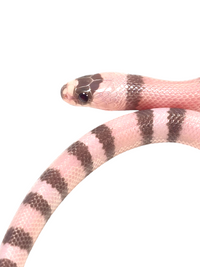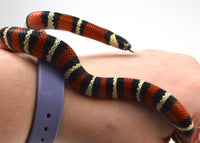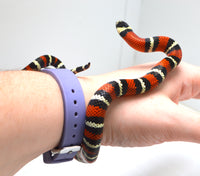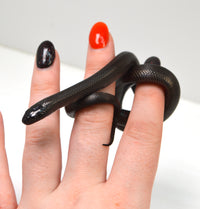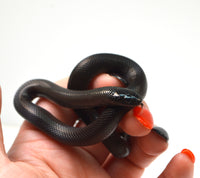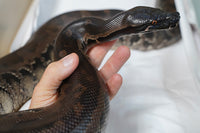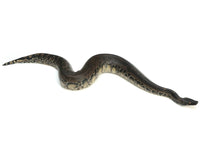Burmese Python FAQs - How To Take Care Of A Burmese Python

Burmese Python Information
Common Name: Burmese Python
Scientific Name: Python Bivittatus
Family: Pythonidae
AKA: “Burm”
General Burmese Python Information
Distribution:
Found from India to lower China, the Malay Peninsula and on some islands of the East Indies.
Wild Status:
Widespread throughout their range but diminishing in population density, Burmese pythons are extensively exploited in the skin trade and large numbers are slaughtered for their meat & ides. When encountered in the bush Burms are often immediately killed for their skin, meat or the simple fact that it is a snake.
Description:
Burmese pythons are large, heavy-bodied serpents. The net-like pattern of a normal Burmese is typically tan or dark brown outlined in yellow and black. The belly is white or cream colored, and the head is large and somewhat blocky.
Hatchling and juvenile Burmese pythons have a tendency to be defensive and nippy, but also become tractable & placid with consistent, gentle handling (use gloves if necessary). Wild caught Burmese pythons typically do not make good pets, as they retain a defensive nature & are much more prone to biting than their captive bred counterparts. A large, angry Burm is a force to be reckoned with!
Burmese Python Size:
Hatchlings: approximately 18″ – 24″+/-.
Adult size: Females average 17′- 20′, males average 10′ – 15′ adult size.
Lifespan: 15 Years
Burmese pythons may live 30 years or more in captivity with proper care.
Color Mutations:
Over the years, many mutations have been produced within Burmese pythons. These mutations are many and varied, from albino, to hypo, to granite, labyrinth, and much more!
Captive Maintenance Guidelines
Difficulty Level:
Intermediate. While Burmese pythons are fairly easy to care for in captivity, their sheer strength and size make them unsuitable for beginner keepers. We recommend Burmese pythons for the intermediate herp keeper with a good understanding of python husbandry.
Please do your homework and assess whether or not you will be able to house an extremely large python with an extremely large appetite for an extremely long time, before making the commitment & purchasing a Burm.
Enclosure:
Enclosures can be as simple or elaborate as one is capable of caring for. Remember that the more “stuff” you put in a cage, the more “stuff” you have to clean & disinfect on a regular basis. That said, there are many different enclosures that work well for Burmese pythons, including, but not limited to: plastic sweater boxes (i.e. Rubbermaid), melamine racks, Freedom Breeder cages, and any of the commercially available plastic-type reptile cages, (i.e. those from Vision Herp & other similar manufacturers).
Glass aquariums & tanks are adequate; keep in mind that the screen tops on such enclosures can make it difficult to maintain humidity levels. Also refer to our Snake Caging care sheet for more information. Juvenile Burmese pythons seem to do well in smaller enclosures that make them feel more secure; a small snake in a big cage can become overwhelmed & stressed.
These snakes grow FAST, so for smaller Burms we recommend setting them up in inexpensive – yet sturdy – caging units until they have done some growing. Better to invest in permanent housing for an adult Burmese than put resources towards expensive caging while your snake is young. This does not mean “throw a small snake into a huge enclosure.”
For large Burms, building an enclosure may be more practical. The length of the cage should be – at a minimum – half the length of the snake. Also, if you must choose between the width of the enclosure & the height, always choose the extra width, as your Burmese will appreciate the extra floor space.
Remember that ALL enclosures must allow for a proper thermal gradient that the snake can utilize, with a hot spot on one end and a cooler spot on the other. This is an extremely important aspect to take into consideration when planning a cage for a very large adult Burmese python.
Substrate:
There are a few substrates that work well. Newspaper is the cheapest & easiest with regards to cleaning & disinfecting: out with the old, in with the new. Cypress mulch is great for controlling humidity but remember that too much humidity can be as detrimental (if not more) as too little. Never use any substrate containing cedar, as this is deadly to reptiles!
Temperatures & Heating:
Provide your Burm with a basking spot of 88-92 °F and an ambient (background) temperature of 78-80 °F. The ambient temperature should not fall below 75 °F. It is vitally important to KNOW the temperatures at which you are keeping your snake(s). DO NOT GUESS!! A great way to monitor temps is to use a digital indoor/outdoor thermometer with a probe. Stick the thermometer to the inside of the cage on the cool end and place the probe on the warm end, and you will have both sides covered at once.
There are several ways to go about heating the enclosure: undercage heating pads, ceramic heat emitters, basking bulbs (both regular daytime & red “night” bulbs) are just a few. With heat emitters & bulbs it is necessary to really keep an eye on the humidity within the enclosure, especially if combined with a screen top, as both will dry the air quickly. Use thermostats, rheostats and/or timers to control your heat source.
Do not use hot rocks with snakes as they often heat unevenly over too small of a surface area & can cause serious burns, not to mention that even the largest heat rock available would quickly be outgrown by a Burmese python.
For heating large Burmese pythons, the various radiant heat panels available specifically for reptiles tend to do a great job. They are manufactured in a range of sizes, so finding one to suit your Burm is only as difficult as contacting the manufacturer to determine which size you need.
Humidity:
Providing proper humidity for Burmese pythons is important to help ensure complete sheds & avoid respiratory infections, but as stated previously too much humidity can be as problematic as too little. First off, let’s establish “humidity” as the amount of moisture in the air. To provide your snake with a humidity level of 50% – 60%, you have a couple of options.
- Use cypress mulch or a similar substrate that can be misted & is mold-resistant. Cypress is good for this as it turns a tan color when dry & a rich brown when wet, giving a visual cue as to when it needs to be dampened again.
- Make a “humidity box” for your snake. This consists of packing a plastic container with damp sphagnum moss (think well-wrung-out wash cloth to gauge moisture), cutting a hole in the top or side & placing it in your python’s enclosure so that it can access the box as it pleases.
- For larger Burmese, you can use a giant Rubbermaid tote if the enclosure allows the space in which to do so. If not, then it is possible to raise ambient humidity by placing a mixture of cypress mulch & sphagnum moss towards the warmer end of the cage, and misting this bedding down frequently.
Keep in mind that if you have a screen top on the enclosure you will probably want to cover it most or all of the way with plastic, a towel or some other means of keeping moisture from escaping. This is also where having proper, reliable ambient temperatures (back to that thermometer!) is important, as warm air holds more moisture than cool air. You want the enclosure to be humid, not WET. A soggy cage can eventually lead to bacterial & fungal infections and consequently, death.
Lighting:
Supplemental lighting is not necessary for this species, but if used should run on a 12/12 cycle, meaning 12 hours on & 12 hours off. Continuous bright, overhead lighting is stressful to snakes, especially a nocturnal serpent such as this one.
Hydration:
Always make fresh, clean water available to your Burmese python, as they have a tendency to drink copiously. The size of the water dish is up to you. If it is large enough for the python to crawl into and soak, sooner or later your snake will make the most of the opportunity, and most seem to enjoy a nice soak from time to time.
Ensure that the bowl is not too deep for juvenile animals – 1″ or so will suffice. Snakes of many species will defecate in their water bowls from time to time, so be prepared for cleaning, disinfecting & a water change when necessary. It is often beneficial to have a spare water bowl for such occasions, so that one may be used while the other is being cleaned.
Caging Accessories:
The one cage accessory that is beneficial to a happy Burmese python is a good hide box; maybe even a couple of them. These are secretive snakes that appreciate & utilize a hide spot. Provide one on each end of your python’s enclosure so that it does not have to choose between temperature & security. Clay flowerpots, plastic flowerpot trays, and commercially available hide boxes all work quite well.
Feeding:
Feed your snake an appropriately sized rodent weekly. A baby Burmese should begin feeding on small adult mice or rat crawlers. They can eat rats from the time they are young – starting off with rat pups or “crawlers” for younger snakes & moving up in size as the animal grows. At 3′, the snake is large enough for weanling rats. At 4′, it is typically capable of consuming adult rats. Do not handle your snake for at least a day after feeding, as this can lead to regurgitation.
Most Burmese pythons have a terrific feeding response and are generally pretty easy to convert to frozen/thawed or pre-killed rodents. Never leave a live rodent unattended with ANY snake. Feed at least once every 10 days, especially with younger rock pythons. While it is somewhat possible to control a snake’s growth rate through maintenance feeding, remember that feeding too infrequently will leave you with a hungry snake that is constantly searching for food, resulting in stronger feeding responses during interaction with handlers. On the other hand, frequent feedings of 1 – 2 times weekly will result in quick growth, so It may be wise to consider how large you wish the snake to get over a certain period of time.
This is a species where developing proper feeding habits is crucial to safe handling, as Burmese pythons are incredibly strong constrictors & a force to be reckoned with when hungry. Never handle rodents and then handle a snake; you may be mistaken as food. As the snake grows to lengths exceeding 6′ it may be wise to feed the snake only dead rodents by placing prey items in the enclosure for the snake to discover, as this may encourage more gentle food acquisition.
You will eventually have to feed your Burmese python very large prey items – i.e. big rabbits. Take the time to find resources for bigger prey items so that you may take into account the acquisition & cost of feeders prior to your Burm reaching adult size.
Cage Maintenance:
Spot-clean your snake’s enclosure as necessary. When feces/urates/uneaten prey items are present, remove them as soon as possible. Clean & disinfect the water bowl on a weekly basis. Depending on cage conditions, remove all substrate & cage furniture and completely disinfect using a 5% bleach solution approximately every 30 days. Rinse the enclosure thoroughly and allow to dry before replacing cage furniture & your snake.
Basic Reproductive Information:
Burmese pythons reach sexual maturity anywhere from 18 months to 4 years of age. Breeding size occurs at lengths of 6′ – 9′ (males) and 9’+ (females). Breeding season in captivity typically ranges from November to March. Stop all feeding at this time. Animals should be well established and in excellent condition before any breeding is attempted. Breeding may be induced by reducing daytime photoperiod to 8 – 10 hours and dropping nighttime temperatures into the mid 70’s. Introduce the male into the female’s cage. Misting the animals with water may induce breeding activity. Females typically shed 14-20+ days after ovulation; eggs are typically laid 30 days after post-ovulation shed. Clutch size for Burmese pythons ranges from 20 – 80+ eggs. At an Incubation temperature of 88 – 90F (optimal), these eggs take between 55 – 70 days to hatch.
Notes:
Burmese pythons are one of the tamest large constrictors known, making them extremely popular pet snakes. Sadly, many people purchase cute little baby Burms as an “impulse buy” before taking into consideration the care and maintenance requirements for such a large, powerful animal.
We encourage all potential Burmese python owners to thoroughly consider whether or not they will be able to eventually house an 18+ foot, 200-lb snake that will require large rabbits as food. For the informed herpetoculturist who is prepared to manage these large, charismatic serpents, the Burmese python can make an extremely rewarding captive that is a joy to interact with and maintain.



